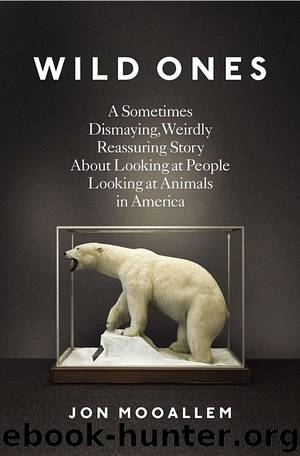Wild Ones by Jon Mooallem

Author:Jon Mooallem
Language: eng
Format: epub
Publisher: Penguin Group, USA
Published: 2013-04-11T16:00:00+00:00
PART THREE
BIRDS
11.
CONSTRUCTION WORKERS
By the late 1940s, there were only about thirty whooping cranes left on Earth, and, for better or worse, America was about to level the clobbering weight of its attention on two of them.
Their names were Pete and Josephine, and they had been paired up at the Audubon Zoo in New Orleans so that they might breed. Pete and Josephine were not breeding, though, probably because the zoo’s spectacularly ignorant superintendent, George Douglass, had confined the towering, long-legged birds to a pen hardly big enough for ducks, then stashed them in a noisy backyard, near the garbage, where they had rats to contend with, little shade to escape the heat, and only washtubs of dirty water to drink from—all of it hewing away at the whooping cranes’ physical and mental health.
Pete, the male bird, seemed especially anxious—“hysterical,” one visitor said. The crane had been a member of what was, by then, the only remaining wild flock of whooping cranes in the world. But in 1936, it was shot in the wing and left for dead while making one of its cohort’s annual migrations between the Gulf Coast of Texas and a remote region of Alberta, Canada. Young sisters in Nebraska, out riding their bicycles, spotted Pete downed in a field and fetched their father, who bagged him. For the next twelve years, Pete would serve as a mascot for a local gun club. He could not fly and was missing one eye.
The crane that Pete had been shipped to New Orleans to mate with, Josephine, was the sole survivor of an encampment of whooping cranes that had once lived in southwestern Louisiana. One old-timer would remember, “It was beautiful to see them up there in the sky, always seven or eight in a bunch, circling and crossing each other like people square dancing.” But by 1941, the Louisiana flock had almost entirely petered out. That fall, Josephine was discovered injured in a rice field and delivered to the zoo in New Orleans. That left only twenty-two whooping cranes in the wild. It would prove to be the all-time low for the species. Some people claim it was worse, that there were actually only fifteen whooping cranes left. Or fourteen. Others say twenty-one. It’s one of many details, I would discover, that people who love the whooping crane can’t agree on.
In fact, one writer notes, it wasn’t long before Pete and Josephine’s predicament in New Orleans incited a “head-on collision” of “two groups of people, both passionate about whooping cranes and passionately opposed to each other on the question of how to preserve them.” The fury kicked off in 1948, when Robert Porter Allen visited the two cranes at the zoo. Allen was an ornithologist who was going to tremendous lengths to revive the species in the wild. Seeing the conditions there, Allen pleaded with George Douglass at least to feed the whooping cranes live blue crabs, which is what whooping cranes like to eat in the wild. Douglass
Download
This site does not store any files on its server. We only index and link to content provided by other sites. Please contact the content providers to delete copyright contents if any and email us, we'll remove relevant links or contents immediately.
Sapiens: A Brief History of Humankind by Yuval Noah Harari(14319)
The Tidewater Tales by John Barth(12625)
Mastermind: How to Think Like Sherlock Holmes by Maria Konnikova(7278)
Do No Harm Stories of Life, Death and Brain Surgery by Henry Marsh(6905)
The Thirst by Nesbo Jo(6877)
Why We Sleep: Unlocking the Power of Sleep and Dreams by Matthew Walker(6654)
Life 3.0: Being Human in the Age of Artificial Intelligence by Tegmark Max(5513)
Sapiens by Yuval Noah Harari(5322)
The Longevity Diet by Valter Longo(5040)
The Body: A Guide for Occupants by Bill Bryson(5027)
The Rules Do Not Apply by Ariel Levy(4910)
The Immortal Life of Henrietta Lacks by Rebecca Skloot(4548)
Animal Frequency by Melissa Alvarez(4425)
Why We Sleep by Matthew Walker(4394)
The Hacking of the American Mind by Robert H. Lustig(4338)
Yoga Anatomy by Kaminoff Leslie(4332)
All Creatures Great and Small by James Herriot(4269)
Double Down (Diary of a Wimpy Kid Book 11) by Jeff Kinney(4240)
Embedded Programming with Modern C++ Cookbook by Igor Viarheichyk(4141)
